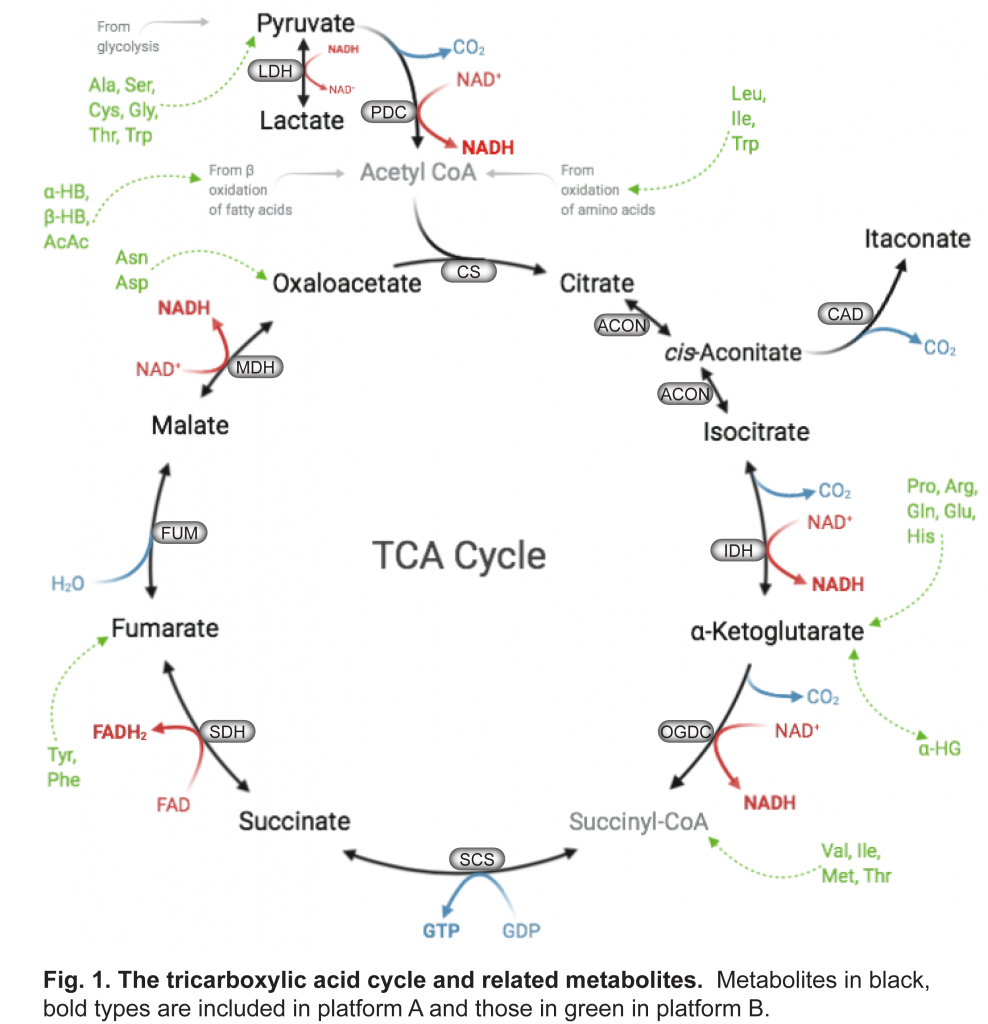What is measured?
Citrate (Cit), isocitrate (iCit), α-ketoglutarate (aKG), fumarate (Fum), malate (Mal), pyruvate (Pyr), lactate (Lac), and succinate (Suc; under development).
Method(s): GC-MS/MS.
The tricarboxylic acid cycle and related metabolites
The tricarboxylic acid (TCA) cycle (also known as the citric acid cycle or Krebs cycle) is a series of reactions forming a loop that ultimately generate energy, mainly by oxidation of acetyl-CoA generated from glycolysis, and catabolism of fatty acids and amino acids. The energy is stored in guanosine triphosphate (GTP), NADH and FADH2 (Figure 1). The citric acid cycle also provides precursors for many compounds, including certain amino acids.
Recent basic research have demonstrated roles of Krebs cycle intermediates in intra- and intercellular signalling affecting physiology and pathogenesis (1). Krebs cycle intermediates have been linked to DNA and histone methylation (α-ketoglutarate and α-hydroxyglutarate), immune modulation (acetyl-CoA, itaconate, fumarate and succinate), thermogenesis (succinate), inhibition of hypoxia state and HIF-α stabilization (succinate, fumarate and α-hydroxyglutarate), and some are considered as “oncometabolites” defined as conventional metabolites that, when aberrantly accumulated, have pro-oncogenic functions (α-hydroxyglutarate, succinate (1), fumarate (2) and lactate (3)).
Studies on metabolomics involving Krebs cycle intermediates in relation to human health and disease usually include few patients and have been performed only recently. These metabolites have been related to BMI, cardiovascular disease (pyruvate, citrate, succinate), diabetes (pyruvate, isocitrate, succinate), NAFLD (isocitrate and citrate), longevity (isocitrate), asthma (succinate), disease activity in rheumatoid arthritis patients (itaconate), and worsening of clinical outcome in cancer patients (succinate, fumarate and α-hydroxyglutarate).
Indication(s)
To investigate the metabolomic signature of human diseases.
Specimen, collection and processing
Matrix: EDTA plasma (preferred) or serum.
Volume: Minimum volume is 60 µL, but 200 µL is optimal and allows reanalysis.
Preparation and stability: Krebs cycle metabolites are probably stable in serum/plasma, but there are concern over oxaloacetate. Samples should be put on ice immediately after collection and stored at -80 °C.
Transportation
Frozen, on dry ice. (for general instruction on transportation, click here)
Reported values, interpretation
Reported values: Cit: 90-200 µmol/L; cAco: 0.9-1.6 µmol/L; iCit: 2-22 µmol/L; aKG: 2-40 µmol/L; Suc: 2-12 µmol/L; Fum: 0.5-4 µmol/L; Mal: 2-21 µmol/L; Oaa: – ; Oxa: 6-12 µmol/L; Pyr: 80-160 µmol/L; Lac: 500-1600 µmol/L; Ita: 0.2-2.3 µmol/L.
Intraclass correlation coefficient (ICC): na.
Literature
1. Martínez-Reyes, I., & Chandel, N. S. (2020). Mitochondrial TCA cycle metabolites control physiology and disease. Nat Commun, 11, 102.
2. Yong, C., Stewart, G. D., & Frezza, C. (2020). Oncometabolites in renal cancer. Nat Rev Nephrol, 16, 156-172.
3. Hayes, C., Donohoe, C. L., Davern, M., & Donlon, N. E. (2021). The oncogenic and clinical implications of lactate induced immunosuppression in the tumour microenvironment. Cancer Lett, 500, 75-86.


